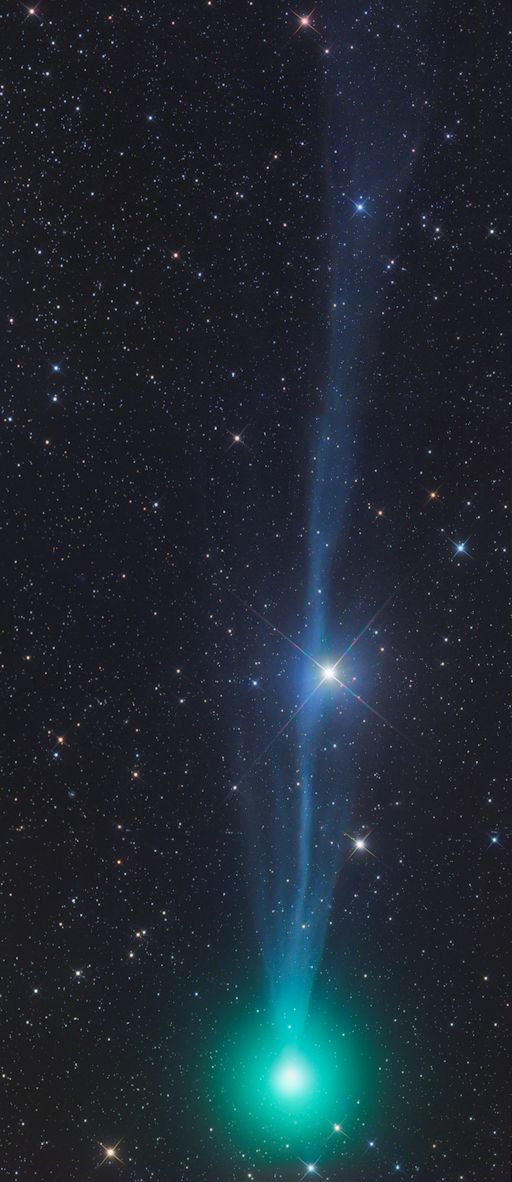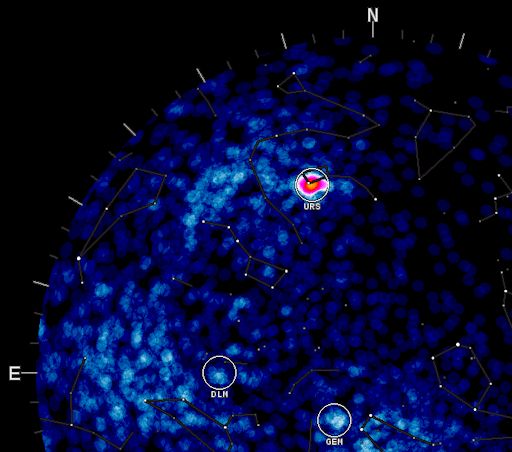Learn to photograph Northern Lights like a pro. Sign up for Peter Rosen's Aurora Photo Courses in Abisko National Park. | | | GEOMAGNETIC UNREST: A fast stream of solar wind is buffeting Earth's magnetic field, prompting NOAA forecasters to raise the odds of a polar geomagnetic storm today to 35%. Arctic sky watchers should be alert for auroras. Aurora alerts: text, voice CHRISTMAS COMET: Is there a cylindrical package under your Christmas tree? Open it now. A small telescope is all you need to see Comet Lovejoy (C/2014 Q2). Discovered just last August by Terry Lovejoy in Australia, the green comet is brightening faster than expected as it moves into northern skies just in time for Christmas. Trace the comet's tail down the page for more information: 
Gerald Rhemann took this picture on Dec. 21st using a remotely-operated telescope in Namibia. The comet's sinuous blue ion tail contrasts beautifully with its puffy green atmosphere. The colors come from ionized carbon monoxide (CO+) and diatomic carbon (C2), which glow blue and green, respectively, in the near-vacuum of interplanetary space. "Last night (Dec. 23rd), the comet was easy to see in binoculars as a 5th magnitude fuzzy star," reports Alan Dyer of New Mexico. "I could just see the comet naked eye knowing exactly where to look south of Orion in the constellation Columba the dove." Where is that? These finder charts from Sky and Telescope can help you find the comet. Better yet, if that cylindrical object is a GOTO telescope, just plug in the comet's coordinates and let the telecope find it for you. Realtime Comet Photo Gallery URSID METEOR OUTBURST: Normally the Ursid meteor shower, which peaks each year on Dec. 21-23, is a minor event, producing no more than about 10 meteors per hour. 2014, however, was different. "The Canadian Meteor Orbit Radar (CMOR) detected a significant outburst near 0 UT on Dec 23rd," reports Peter Brown, director of the Centre for Planetary Science and Exploration at the University of Western Ontario. Scroll past this radar map of the Ursid radiant for more information: 
"In all," he says, "we recorded close to 100 Ursid orbits with CMOR during the 1.5 hours of the outburst (from 2315 UT Dec 22 – 0045 Dec 23). This was more than a factor of two above any other Ursid outburst CMOR has recorded in the last dozen years. The radar map shows a very tight cluster of Ursids from the 1.5 hour outburst 'pouring' right out of the bowl of the Little Dipper." Ursid meteors are debris from parent Comet 8P/Tuttle. The outburst was predicted by astronomer Jérémie Vaubaillon, whose computer models suggested Earth might cross an old filament of comet dust shed by 8P/Tuttle, causing a surge in meteors around 0 UT on Dec. 23rd. Solar flare alerts: text, voice Realtime Meteor Photo Gallery
Realtime Space Weather Photo Gallery
Realtime Aurora Photo Gallery
Every night, a network of NASA all-sky cameras scans the skies above the United States for meteoritic fireballs. Automated software maintained by NASA's Meteoroid Environment Office calculates their orbits, velocity, penetration depth in Earth's atmosphere and many other characteristics. Daily results are presented here on Spaceweather.com. On Dec. 24, 2014, the network reported 15 fireballs.
(10 sporadics, 5 December Leonis Minorids)  In this diagram of the inner solar system, all of the fireball orbits intersect at a single point--Earth. The orbits are color-coded by velocity, from slow (red) to fast (blue). [Larger image] [movies] Potentially Hazardous Asteroids ( PHAs) are space rocks larger than approximately 100m that can come closer to Earth than 0.05 AU. None of the known PHAs is on a collision course with our planet, although astronomers are finding new ones all the time. On December 24, 2014 there were potentially hazardous asteroids. Recent & Upcoming Earth-asteroid encounters: | Asteroid | Date(UT) | Miss Distance | Size | | 2007 EJ | Jan 12 | 68.9 LD | 1.1 km | | 1991 VE | Jan 17 | 40.6 LD | 1.0 km | | 2004 BL86 | Jan 26 | 3.1 LD | 650 m | | 2008 CQ | Jan 31 | 4.8 LD | 36 m | | 2000 EE14 | Feb 27 | 72.5 LD | 1.6 km | Notes: LD means "Lunar Distance." 1 LD = 384,401 km, the distance between Earth and the Moon. 1 LD also equals 0.00256 AU. MAG is the visual magnitude of the asteroid on the date of closest approach. | | The official U.S. government space weather bureau | | | The first place to look for information about sundogs, pillars, rainbows and related phenomena. | | | Researchers call it a "Hubble for the sun." SDO is the most advanced solar observatory ever. | | | 3D views of the sun from NASA's Solar and Terrestrial Relations Observatory | | | Realtime and archival images of the Sun from SOHO. | | | from the NOAA Space Environment Center | | | the underlying science of space weather | | 
